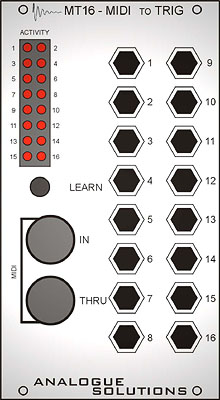| Module |
Description |
Controls & Ins/Outs |
 |
MT16 MIDI to
Trigger / Gate converter
The MT16 is an advanced MIDI to triggering module. It
allows triggering of a range of analogue devices; drum voice modules, envelope modules,
analogue sequencers, analogue drum machines, and anything else with a gate, trigger or
clock input.
It has 16 separate outputs, so 16 devices can be
independently triggered via separate MIDI keys.
Each output can be re-mapped to any MIDI key, and any
global MDI channel can be selected. |
Inputs:
MIDI InOutputs:
16 independent trigger outs
MIDI Thru
Power supply:
+5V, GND using Integratoror, Doepfer A100 power sockets
Controls:
Learn button
Indicators:
16x Actuiviry LEDs
Size:
14HP |
Use
Connect the MIDI sequencer or other MIDI device to the MIDI
input of the MT16. Connect MT16 trigger outputs to device you wish to trigger.
Programming
• Programming the MT16 is a very simple proceedure.
• Press the LEARN button. The 1st LED will flash, and triggers will be sent out of
output 1.
• The MT16 will now be in MIDI omni-on mode, so it will receive information on all
MIDI channels.
• Press the MIDI key you wish output 1 to be assigned to. Output 1 will be assingned
to that note number. The MT16 will set its MIDI receive channel (which will be the same
for all outputs) to the MIDI channel the keyboard is transmitting on.
• Continue to program the following 15 outputs by
pressing each key your wish to assign them to in turn.
• As each key is pressed, the next LED flashes and triggers are sent out of the
respective output.
• After all 16 outputs are assigned the unit returns to normal mode.
• If you wish to skip programming any individual output, simply press the LEARN
button to skip outputs.
Set-up information is stored in non-volatile memory.
Information is retained when the power is switched of or module disconnected from power
board. No battery back-up is required!
If the set-up is altered for any unpredictable reason (for
example power disconnected during programming), the factory default program will be loaded
at start-up. Factory default is MIDI channel 1, Output 1 set to C60, the next 15 outputs
set to the next 15 keys.
To change the MIDI channel without affecting the note
mapping, program only the first note, skipping the next 15.
Uses
Triggering Drum Voices
The most logical use for the MT16 is for easy programming
of Concussor drum voice modules via a MIDI sequncer. Electronic percussion patterns can be
quickly created using for example Cubase's grid editor or a rhythm sequencer such as the
Akai MPC2000.
Gating Envelopes
The MT16 is infact a MIDI to Gate unit, therefore it
retains sustain information. When you hold a MIDI key down, the trigger output will stay
on (+5V) till the key is released. This makes the MT16 ideal for controlling envelopes.
Switchers and Fill In Modules (FS01)
As the MT16 retains note length information (see Gating
above), it can be used to hold open and close switchers or the Concussor Fill-In module.
Devices with Clock Inputs - MT16 is more
advantagous than using a MIDI-Sync device!
The MT16 offers a much more flexible way of synchronising
analogue sequencers and drum machines than using a MIDI-Sync device. MIDI-Sync devices
have the problem that they run continually when your MIDI sequencer is running. Therefore
you cannot stop and re-start your analogue sequencers mid-song. Using the MT16 this
problem can be overcome. By programming a bar of 16th notes and looping the bar, straight
away you have created a clock signal that your analogue sequencers can lock on to. But
there are several important advantages - you can have up to 16 clock signals, they can all
be different divide ratios by changing the note pattern (so you could say have one
sequencer running half the speed of the other). The string of notes does not have to be a
steady pattern, it can be a syncopated rhythm, clocking you analogue sequencers in a
particular changing pattern you decide.
